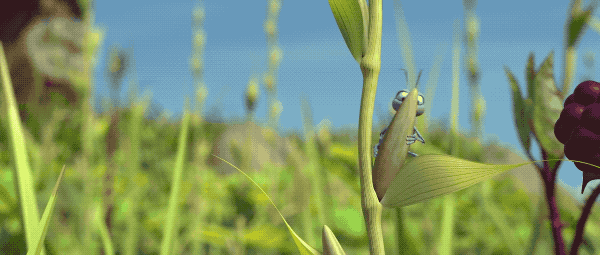Pulling Focus: Photorealist Detailing in Pixar Animation Studios' A Bug's Life
Within the popular imagination of the commercially and critically lauded Pixar Animation Studios, A Bug's Life (John Lasseter, 1998) represents something of a "forgotten" feature film, flanked by the first two instalments of the highly successful Toy Story franchise and often considered indistinguishable from the DreamWorks studio's rival feature Antz (Eric Darnell and Tim Johnson, 1998), released only a month earlier. Yet, while Antz and A Bug's Life are both computer-animated features united in the spotlight they shine on the tribulations of underground ant colonies, the two insect-themed epics are markedly different in their respective visual styles and design policies. The anthropological accuracy of Antz is one rooted in a high level of anatomic and humanistic realism, which advanced the realist aesthetics of emergent computer graphics by accurately simulating organic form.1 At a distance from Antz's angular, six-legged ant colony, A Bug's Life retains a perceptible level of stylisation within its character design. Led by the idealistic Flik, the army of pastel coloured ants that populate Pixar's film (complete with rounded sympathetic bodies with two legs and two arms) occupy a compromise position between the poles of realism and illustration, fidelity and imagination.
Gaining what Paul Wells labels as "conviction through caricature," A Bug's Life's treatment of the creatures within its micro-narrative (including fleas, grasshoppers, ladybirds and stick insects) does not extend to the film's lush island setting, and the characters remain somewhat aesthetically incongruous with their natural surroundings.2 The film's opening articulates this mismatch in a sequence that marries the stylised reality of character animation with a photorealistic vision of the rolling virtual landscapes and a natural world bathed in sunlight. Following an opening shot that delights in the pleasures of digital imperfection (a lens flare "confirms" the presence of a glass-fronted lens), the virtual camera shifts its focus for the first time. An autumn leaf falling into shot "ripples" the image and exposes this first shot of the blue sky to have been reflected in water, thereby playing with the computer-animated illusion through the self-reflexive manipulation of the spectators' ways of seeing. The camera in A Bug's Life next tilts upwards to reveal the sun-bleached riverbed veined with mudcracks that will later provide the ants with security and shelter, before slowly tracking in towards (and through) the flowers, grasses and plants that grow on Ant Island.
The natural environment and its density of foliage on display in this unbroken take (totalling exactly one minute) mimics real world ecology, infused with a biological coherency that persuasively mimics the conditions of soil, grasslands and flowers. Even the fluctuating volume of the bioacoustics on the soundtrack correlate with the camera's journey deeper into the digital wildlife. Director John Lasseter has stressed, "We did a lot of research of real bugs, of real insects and the world they live in," which aided their rendering of a natural world with which the audience would be familiar.3 Lasseter also enthuses about the way Pixar were inspired by – and adhered to – miniature details like individual beads of water resting on leaves, how "the physics of adhesion was greater than the physics of gravity," the imperceptible movement of grass in the wind, and the translucency of leaves illuminated by sunlight and shot innovatively from the ground up.4
As the opening sequence to A Bug's Life proceeds, however, the organic images of pristine visual illusionism are abruptly destabilised by the appearance of a purple ant who runs hurriedly up the nearest stalk (to the camera), dislodges a seed from its root and drops the grain to the ground below. Once the industrious ant has finished its latest food harvest, the virtual camera pulls focus for a second time, this time bringing more background insect workers into view at the expense of the first ant, now blurry and visually undefined nearest the camera. The momentary simulation of analogue cinema and the formal replication of lens-based media gives the impression of the digital element (character, setting) as pro-filmic events occurring, acting and performing in front of the camera. The pulled focus is a detail that operates in service of A Bug's Life's photorealist credentials, that is to say in the construction of images that are indistinguishable from real-life, genuine photographs. William Brown argues that, "We can read photorealism, then, as being firstly an affirmation of the simulacral nature of digital images: they look not like original reality, or real life, but like copies of that reality, i.e. like photographs, which makes digital images like copies of copies."5 In A Bug's Life, the "simulacral" possibilities of digital imagery that are accomplished through the camera's pulled focus marks the moment in which the photorealism of the film's landscapes and the entomologically inaccurate insects collide to affirm A Bug's Life's pictorial engagement with "cartoons and illustration."6
Although not perhaps as well-remembered as Pixar's other feature films, A Bug's Life represents an important step in the development of computer graphics in popular cinema. It demonstrates from the outset the "flaws-as-flourish" philosophy that effectively underscores photorealism, and it works through precisely how the ontology of the photographic image and photographic indexicality began to evolve into a set of repeatable formal preoccupations. Pixar's film delegates to its opening sequence the ability to show exaggerated illustration and photorealism in one shot, which, in a parallel to the narrative's themes of co-operation and collective action, must work together as part of A Bug's Life's particular formal style. Indeed, it is ultimately the arrival of the ants into sudden view (and their immediate coding as living, working, pro-filmic bodies) that A Bug's Life's conciliatory aesthetic between the photoreal and the cartoon comes strikingly into view.

